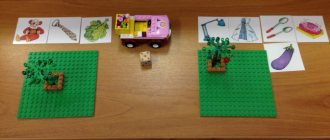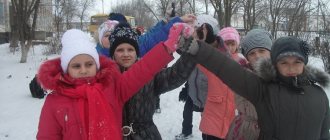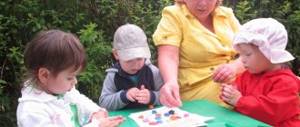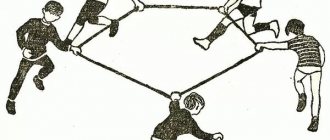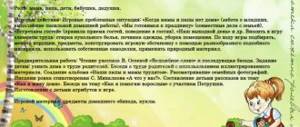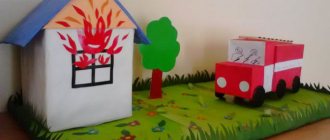MUSICAL COMMUNICATION GAMES
Game "Hello!" (Danish folk tune)
Goal: development of attention, hearing, motor response, ability to navigate in space; developing a positive attitude towards other people; learning the ability to easily communicate with a partner.
Progress of the game
Part 1: children move in all directions.
Part 2: clap 3 times, spin to the right, then repeat the movements to the left.
End: find a partner, extend your hand, shake, say: “Hello!”
Game "Search!" (music by T. Lomova)
Goal: development of attention, ability to navigate in space, ability to interact with a partner, express a positive attitude towards each other, coordinate your actions with the actions of your partner.
Progress of the game
1st part: children stand in a circle in pairs facing the center, the driver is in the middle (the one standing behind the partner looks to the right and left from behind the shoulder of the one in front and says: “Look!”, then runs to the other partner (the one standing in front remains in place ).
2nd part: those standing behind run out into a circle, take the driver with them and move in a circle.
End: find a mate, stand in front of your partner; whoever has not found a mate becomes the driver.
Game "Nose to nose"
Goal: developing the ability to communicate with various playing partners; formation of friendly relationships.
Progress of the game
Children move scatteredly, after the end of the music or at a signal, find a partner and touch him with their nose, hand, shoulder, back, etc.
Game "Aram-shim-shim"
Goal: to show sympathy for each other and mutual respect.
Progress of the game
All players stand in a circle, with the driver in the center of the circle. The driver closes his eyes, extends his hand forward, and spins clockwise with his eyes closed. All players in a circle, hold hands and dance around the leader (counterclockwise) and pronounce the words:
Aram-shim-shim, aram-shim-shim.
Aramia-Dulcia, point to me.
North West South East
Stop!
Everyone stops. To whom the driver's hand points, he goes to the center of the circle and stands with his back to the driver. Then everyone chants the words “One, two, three!” Look one way." The player with the driver must turn their head in any direction. If they turned to different sides, they shook hands, if they turned to the same side, they hugged in a friendly way.
MAGAZINE Preschooler.RF
Outline of GCD in the preparatory group “The Queen of Mathematics is visiting us”Integration of educational areas: “Cognition” , “Communication” , “Socialization” , “Artistic Creativity”
Objectives: “Cognition”
- Develop the ability to solve logical problems, write them using numbers and signs
- Fix the composition of the number 8 from two smaller ones.
- Set the names of the days of the week
- Practice orientation on a piece of paper
- Develop logical thinking, fine motor skills, cognitive interest.
"Communication"
- Develop skills in talking about your actions.
- Activate the names of geometric signs and figures in speech.
"Artistic creativity"
- Develop skills in drawing and painting geometric shapes.
"Socialization"
- To develop the ability to act in games, following the rules.
Methods and techniques: - Practical: outdoor game “Stream” , game exercise “Name the neighbors” , game “Living Week” , game “Sweet Shop” , drawing a rug.
- Verbal: questions for children, asking riddles and tasks.
- Visual: Visual aid “Store Showcase” .
Materials and equipment: Math sets, felt-tip pens, squared notebooks, a set of numbers, a basket of chips, a teaching aid for the game “Shop” .
The logic of direct educational activities:
Surprise moment. Making a riddle: “Motley fidget.
Long-tailed bird. The bird is talkative. The most talkative."
A magpie appears. She brings news from Queen Mathematics on her tail:
“I’m flying to visit you, but I can’t land. Help me, count to 10 and back."
The children count and the Queen of Mathematics appears. -Hello my friends, I’m glad to see you all. Do you recognize me?
-What kind of residents live in my kingdom? (children's answers)
-Do you like mathematics? I have prepared math tasks and games for you. Are you ready to fulfill them? Aren't you afraid of difficulties? Then let's begin.
Listen carefully to the tasks, for the correct answer you will receive a chip.
Game exercise “Name your neighbors” . The game is played with a ball, standing in a circle. Children take turns naming the neighbors of the named number.
Game "Guess the number from the riddle" . -I thought of a number, if you subtract one from it, you get 8. What number is this? Label it with a number and place it in your palm. Name the neighbors of the number 9. What else do you know about this number?
The game "Stream" on the composition of the number 9 from two smaller ones. Children run around the group to the music with numbers in their hands. To the signal: “Streams into the gate!” run up to the gate, stand in pairs so that the sum of the numbers is 9 and talk about how the number 9 is composed.
Game "Sweet Shop"
The Queen of Mathematics invites children to the store to buy sweets. On a magnetic board there is a teaching aid with the image of pasted-on chocolate and fruit juice wrappers, only 6 pieces at a price of 5, 6, 4, 3, 7, 2 rubles. The Queen offers to buy two sweets worth 9 rubles. Children buy and tell why they made the purchases they did.
Riddles-tasks.
The Queen of Mathematics gives children riddles, and the children “write down” using numbers and signs on a magnetic board.
- “Masha had five flowers, Dasha gave her two.
How many flowers does Masha have?
- “Six cheerful piglets stand in a row at the trough.
The two ate their fill and went to bed. How many piglets are there at the trough?”
- There were seven candles burning on the table, two were extinguished. How many candles are there on the table?
Game "Live Week"
Children run around the group to cheerful music. To the signal: “Get ready for the week!” arranged in order from one to seven. Tasks for children:
- Last day of the week, step forward!
- Wednesday, name your neighbors
- Friday, what day of the week is in front of you?
- Saturday, what day of the week is after you?
- day of the week that stands between Monday and Wednesday, clap your hands
- Monday, how many days are there in a week?
- day of the week before Friday, sit down!
Graphic dictation
The Queen of Mathematics asks children to draw rugs of geometric shapes as souvenirs for her.
“Open your notebooks, take markers and start drawing.
Triangle in the upper right corner, trapezoid in the lower left, circle in the upper left, oval in the lower right.” Then the children compare their drawings with the model and tell whether they did it correctly.
Reflection. Which task was difficult and which was interesting?
Compiled by: Dubrovina Aleftina Viktorovna, teacher of the secondary educational institution No. 1 "OC" of Bolshaya Glushitsa - kindergarten No. 3 "Little Red Riding Hood" of the Bolsheglunitsky municipal district, Samara region, Russian Federation.
| Next > |
Text of the book “Collection of outdoor games. For working with children 2-7 years old"
Collection of outdoor games. For working with children 2-7 years old
Methodology for conducting outdoor games
Outdoor play as a means of harmonious development of a child
An outdoor game with rules is a child’s conscious motor activity, characterized by the accurate and timely completion of tasks related to the rules that are mandatory for all players. According to P. Lesgaft’s definition, outdoor play is an exercise through which a child prepares for life. The exciting content and emotional richness of the game encourage the child to make certain mental and physical efforts.
The specificity of outdoor play is the child’s lightning-fast, instant response to the signals “catch!”, “run!” “stop!” and etc.
Outdoor play is an indispensable means of replenishing a child’s knowledge and ideas about the world around him, developing thinking, ingenuity, dexterity, dexterity, and valuable moral and volitional qualities. When conducting outdoor play, unlimited opportunities are created for the integrated use of various methods aimed at shaping the child’s personality. During the game, not only the exercise of existing motor skills occurs, their consolidation and improvement, but also the formation of personality qualities.
Many domestic scientists have been searching for ways to harmoniously develop children. Thus, in the system of physical education created by P. Lesgaft, the principle of harmonious development was fundamental, and the physical and spiritual forces of a person were considered as qualitatively different aspects of a single life process, allowing the formation of people of the “ideally normal type.” According to P. Lesgaft, harmonious development is possible only with a scientifically based system of physical education and upbringing, in which the principle of awareness prevails.
Awareness of movements provides the opportunity to use them rationally and economically, perform them with the least expenditure of effort and with the greatest effect, and also contributes to the spiritual development of a person.
Numerous studies prove that a person’s character, thoughts, and feelings are reflected in the form of a “muscular shell” on the body (M. Alexander, V. Reich, M. Feldenkrais, etc.), therefore, in order to achieve the goals of harmonious development, it is important to understand how our body works . The teacher must teach children to move naturally, gracefully, in accordance with the constitution of the body and individual abilities.
Harmonious development occurs with a holistic, integrated, balanced realization of all human potential. One-sided development is detrimental to the individual and often borders on psychological or physical illness.
The child realizes freedom of action in outdoor games, which are a factor in the formation of physical culture. In pedagogical science, outdoor games are considered as the most important means of a child’s comprehensive development. The deep meaning of outdoor games lies in their full role in physical and spiritual life, their significance in the history and culture of every nation. Outdoor play can be called the most important educational institution, promoting both the development of physical and mental abilities and the development of moral norms, rules of behavior, and ethical values of society.
Outdoor games are one of the conditions for the development of a child’s culture. In them he comprehends and learns about the world around him, in them his intellect, fantasy, imagination develop, and social qualities are formed. Outdoor games are always a creative activity that demonstrates the child’s natural dexterity in movement and the need to find a solution to a motor problem. While playing, a child not only learns about the world around him, but also transforms it.
Children of primary preschool age imitate everything they see in play. However, in the outdoor games of children, what is primarily reflected is not communication with peers, but a reflection of the life of adults or animals: they fly with pleasure like sparrows, flapping their arms like a butterfly with its wings, etc. The desire to spiritualize inanimate nature is explained by the child’s desire to give The image depicted in the game has a living character. When he gets used to the image, the mechanisms of empathy are turned on and, as a result, morally valuable personal qualities are formed: empathy, complicity, involvement. Thanks to the developed ability to imitate, most outdoor games of younger preschoolers are plot-based.
In the fifth year of life, the nature of children's play activities changes. They begin to be interested in the result of outdoor play, they strive to express their feelings, desires, implement their plans, and creatively reflect the accumulated motor and social experience in their imagination and behavior. However, imitativeness and imitation continue to play an important role in older preschool age.
Outdoor games are characterized by the presence of moral content. They foster goodwill, a desire for mutual assistance, conscientiousness, organization, and initiative. In addition, playing outdoor games is associated with great emotional uplift, joy, fun, and a sense of freedom. Outdoor games of different content allow us to trace the variety of approaches to finding ways for the harmonious development of children. Conventionally, we can distinguish several types of outdoor games that contribute in different ways to the comprehensive development of preschool children and carry different social orientations. Games like “Traps” are characterized by a creative nature, based on passion, motor experience and strict adherence to the rules. By running away, catching up, dodging, children mobilize their mental and physical strength to the maximum, while they independently choose methods that ensure the effectiveness of game actions and improve psychophysical qualities.
Games that require inventing movements or instantly stopping an action at a game signal encourage children to individual and collective creativity (inventing combinations of movements, imitating the movements of vehicles, animals).
Such games are at the same time an exercise for will, attention, thought, feeling and movement. Particular attention is paid to the expressiveness of actions invented by children, which activate mental processes, carry out sensory corrections, role training, form the psychosomatic and emotional spheres, developing the mechanisms of empathy. Children convey the character and images of the game characters, their moods, and relationships. At the same time, facial and large muscles are trained, which contributes to the release of endorphins (the hormone of joy), which ensures an improvement in the condition and functioning of the body.
Ball games play a particularly important role when working with children. While playing, a child performs various manipulations with the ball: aiming, hitting, throwing, throwing, combining movements with claps, various turns, etc. These games develop the eye, motor coordination functions, and improve the activity of the cerebral cortex. According to A. Lowen, hitting a ball improves mood, relieves aggression, helps get rid of muscle tension, and causes pleasure. Pleasure, in his opinion, is freedom of body movement from muscle tension.
Games with elements of competition require proper pedagogical guidance, which requires compliance with a number of conditions:
Each child participating in the game must be proficient in the motor skills (climbing, running, jumping, throwing, etc.) in which the game is competed. This principle is also fundamental in relay games. It is also important to objectively evaluate the activities of children when summing up the results of the game: it is necessary to evaluate the child’s achievements in relation to himself, that is, his own achievements, because each child has his own characteristics, his own capabilities, determined by his state of health, sensory and motor experience.
In games like “Blind Man's Bluff” and “Guess by Voice”, analyzer systems are improved and sensory corrections are carried out.
Thus, by playing and implementing various forms of activity, children learn about the world around them, themselves, their body, their capabilities, invent, create, while developing harmoniously and holistically.
In the formation of a child’s diversified personality, active games with rules are given the most important place. They are considered as the main means and method of physical education. Outdoor games have a healing effect on the child’s body - he practices a wide variety of movements: running, jumping, climbing, climbing, throwing, catching, dodging, etc. At the same time, breathing and metabolic processes in the body are activated, this, in turn, has a beneficial effect on mental activity. The healing effect of outdoor games is enhanced when played outdoors.
It is extremely important to take into account the role of growing tension, joy, strong feelings and undying interest in the results of the game that the child experiences. Passion for the game not only mobilizes his physiological resources, but also improves the effectiveness of movements. Play is an indispensable means of developing and improving movements; formation of speed, strength, endurance, coordination of movements. In outdoor play as a creative activity, nothing fetters the child’s freedom of action; he is relaxed and free.
The role of outdoor play in mental education is great: children learn to act in accordance with the rules, act consciously in a changed game situation and learn about the world around them; master spatial terminology. During the game, memory and ideas are activated, thinking and imagination are developed. Children learn the meaning of the game, remember the rules, learn to act in accordance with their chosen role, creatively use existing motor skills, and learn to analyze their actions and the actions of their comrades. Outdoor games are often accompanied by songs, poems, counting rhymes, and game starters. Such games replenish vocabulary and enrich children's speech.
Outdoor games are also of great importance in the moral education of preschool children. Children learn to act in a team and obey common requirements. The guys perceive the rules of the game as law; conscious implementation of them forms the will, develops self-control, endurance, and the ability to control one’s actions and behavior. Honesty, discipline, and justice are formed in the game. Outdoor play teaches sincerity and camaraderie. By obeying the rules of the game, children learn to be friends, empathize, and help each other.
Skillful, thoughtful management of the game by the teacher contributes to the development of an active creative personality. In outdoor games, the aesthetic perception of the world is improved. Children learn the beauty of movements, their imagery; master poetic, figurative speech; they develop a sense of rhythm.
Outdoor play prepares for work: children make play attributes, arrange and put them away in a certain sequence, and improve their motor skills necessary for future work.
Thus, outdoor play is an indispensable means of replenishing a child’s knowledge and ideas about the world around him; development of thinking, ingenuity, dexterity, dexterity, valuable moral and volitional qualities. When conducting outdoor play, there are unlimited possibilities for the integrated use of various methods aimed at shaping the child’s personality. During the game, not only the exercise of existing skills occurs, but also the formation of new mental processes, new personality traits.
Outdoor games as a means of physical education contribute to the child’s health through playing in the fresh air, and also activate creative activity, independence, manifestations of looseness, and freedom in solving gaming problems.
As a method of physical education, outdoor play helps to consolidate and improve the child’s movements.
Features of outdoor games
Outdoor games are classified by age, by the degree of mobility of the child in the game (games with low, medium, high mobility), by types of movements (games with running, throwing, etc.), by content (outdoor games with rules and sports games) .
In the theory and methodology of physical education, the following classification of games is accepted.
Outdoor games with rules include plot and non-story games. Sports games include basketball, gorodki, table tennis, hockey, football, etc.
Plot-based outdoor games reflect a life or fairy-tale episode in a conventional form. The child is captivated by playful images. He creatively embodies himself in them, depicting a cat, a sparrow, a car, a wolf, a goose, a monkey, etc.
Story-based outdoor games contain motor game tasks that are interesting for children and lead to achieving a goal. These games are divided into games such as dashes, traps; games with elements of competition (“Who will run to their flag the fastest?”, etc.); relay games (“Who will pass the ball sooner?”); games with objects (balls, hoops, serso, skittles, etc.). When working with the youngest children, they use fun games (“Ladushki”, “Horned Goat”, etc.).
The methodology for conducting outdoor games includes unlimited possibilities for the integrated use of various techniques aimed at shaping the child’s personality and skillful didactic guidance of the game.
Of particular importance are the professional training of the teacher, pedagogical observation and foresight. By stimulating a child’s interest in play, engaging him in play activities, the teacher notices and highlights significant factors in his development and behavior; determines (sometimes in individual strokes) real changes in knowledge, skills and abilities. It is important to help the child consolidate positive qualities and gradually overcome negative ones. Pedagogical observation and love for children allow the teacher to thoughtfully choose methods for guiding their activities, correct the child’s behavior and his own; create a joyful, friendly atmosphere in the group. The children's joy that accompanies play contributes to the formation of the child's physical, mental, spiritual, aesthetic and moral qualities.
The method of conducting outdoor play is aimed at educating an emotional child who consciously acts to the best of his abilities and has a variety of motor skills. Under the benevolent, attentive guidance of the teacher, a creatively thinking person is formed who knows how to navigate the environment, actively overcome the difficulties encountered, show a friendly attitude towards comrades, endurance, and self-control.
A prerequisite for successful outdoor games is taking into account the individual characteristics of each child. Behavior in the game largely depends on existing motor skills and typological characteristics of the nervous system. Active motor activity trains the child’s nervous system and helps balance the processes of excitation and inhibition.
The selection of outdoor games depends on the working conditions of each age group: the general level of physical and mental development of children, their motor skills; the health status of each child, his individual typological characteristics, time of year, daily routine, place of play, children’s interests.
When selecting plot-based outdoor games, one should take into account the children’s developed ideas about the plot being played out. A prerequisite for preparing a teacher to conduct outdoor games is preliminary learning of the movements of both imitation and physical exercises, actions that children perform in the game. The teacher pays attention to the correct, relaxed, expressive performance of motor actions. To better understand the game plot, the teacher carries out preliminary work: reads works of fiction, organizes observations of nature, animals, the activities of people of various professions (drivers, athletes, etc.), watching videos, films and filmstrips, conversations. The teacher pays considerable attention to preparing the attributes of the game - he makes the attributes together with the children or in their presence (depending on age).
It is important to organize the game correctly in terms of content and order of tasks. The game can be played simultaneously with all children or with a small group. The teacher varies the ways of organizing games depending on their structure and nature, and the location of the movements. Thinks through ways to gather children for the game and introduce game attributes.
Introducing children to a new game is carried out clearly, concisely, figuratively, emotionally and lasts 1.5–2 minutes. An explanation of the plot-based outdoor game, as already noted, is given after preliminary work on the formation of ideas about game images.
The themes of plot-based outdoor games are varied: these can be episodes from people’s lives, natural phenomena, or imitation of animal habits. In the course of explaining a new game, a game goal is set for children, which helps to activate thinking, understand the rules of the game, and form and improve motor skills. When explaining the game, a short figurative storyline is used. It changes in order to better transform the child into a playful image, develop expressiveness, beauty, graceful movements, fantasy and imagination. The plot story is similar to a fairy tale, which evokes in children a reconstructive imagination - a visual perception of all play situations and actions that stimulate them to emotional perception.
The plot of the story and its content should be understandable to children, therefore the use of this technique requires planning and thinking through the teacher’s previous work so that the children have an idea of the plot being played out. The teacher observes in nature, in a living area, the behavior of birds and animals; reads fiction, shows filmstrips, videos, films, creating ideas necessary for the successful implementation of the game. Instead of a situational explanation of the game, the teacher uses a little fairy tale or a plot story before the first game, which includes the rules of the game and a signal. Their explanation takes the same 1.5-2 minutes allotted by the technique, and sometimes less. The educational effect of such an explanation is high - children develop a recreating imagination and fantasy. The plot story helps to get into character and develop expressive movements. The rules and signal are woven into the explanation of the game.
Storytelling is used in all age groups. It is often difficult for a teacher to come up with an explanation for the game. To make the task easier, you can use poetry. For example:
A crested hen came out, with yellow chicks with her. The chicken clucks: “Ko-ko, don’t go far.”
The “chicken” children walk along the lawn, collect grains for the driver, and drink water from the puddle. Approaching the “cat” driver, the “chicken” (teacher) says:
On a bench, by the path, a cat lay down and dozed.
The “chickens” come close to the “cat”, the “hen” says:
The cat opens its eyes (Meows: “Meow-meow.”)
And catches up with the chickens.
When explaining a non-story game, the teacher reveals the sequence of game actions, game rules and signal. He indicates the location of the players and game attributes using spatial terminology (in younger groups with a focus on the object, in older groups without it). When explaining the game, the teacher should not be distracted by comments to the children. Using questions, he checks how the children understand the game. If the rules are clear to them, then the game is fun and exciting.
When explaining games with competition elements, the teacher clarifies the rules, game techniques, and competition conditions. Expresses confidence that all children will try to cope well with game tasks that require not only speed, but also high-quality execution (“Who can reach the flag faster”, “Which team will not drop the ball”). Correct execution of movements gives children pleasure, creates a feeling of confidence and a desire for improvement.
By uniting those playing in groups or teams, the teacher takes into account the physical development and individual characteristics of the children. Selects guys of equal strength for teams; to activate insecure, shy kids, it unites them with brave and active kids.
Children's interest in games with elements of competition increases if they wear a uniform and choose team captains, a referee and his assistant. Teams receive points for completing tasks correctly and quickly. The result of the calculation determines the assessment of the quality of task performance and collective actions of each team. Conducting games with elements of competition requires great pedagogical tact, objectivity and fairness in assessing the activities of teams, promoting friendliness and camaraderie in the relationships of children.
The teacher's guidance of outdoor play also consists of the distribution of roles. The teacher can appoint a driver, select using a counting rhyme, or invite the children to choose a driver themselves and then ask them to explain why they assign the role to this particular child; can take the leading role or choose someone who wants to be the leader. In younger groups, the role of leader is initially performed by the teacher, doing it emotionally and figuratively. Gradually, the role of the leader begins to be entrusted to children.
During the game, the teacher pays attention to the children’s compliance with the rules and carefully analyzes the reasons for their violation. A child may break the rules of the game if he did not understand the teacher’s explanation accurately enough, really wanted to win, was inattentive, etc. The teacher must monitor the movements, relationships, workload, and emotional state of the children in the game.
Considerable attention should be paid to options for outdoor games, which allow not only to increase interest in the game, but also to complicate mental and physical tasks; improve movements, increase the psychophysical qualities of the child.
Initially, the teacher comes up with game options himself or selects them from collections of outdoor games. In this case, the rules should be gradually complicated. For example, the teacher intonationally varies the interval of the signal: “One, two, three, catch!”, “One – two – three – catch!” etc.; it can change the arrangement of children and physical education aids in the game; choose several drivers; include rules in the game that require the child to have endurance, self-control, etc.
Children are gradually getting involved in creating options, which contributes to the development of children's creativity.
By leading the game, the teacher forms correct self-esteem, friendly relationships, friendship and mutual assistance, and teaches children to overcome difficulties. P. Kapterev called overcoming difficulties moral hardening, linking it with the formation of high spiritual potential. Correct pedagogical guidance of the game helps the child understand himself and his comrades, ensures the development and realization of his creative powers, and has a psychocorrective and psychotherapeutic effect.
Summing up the game, the teacher notes the children who performed their roles well, showed ingenuity, endurance, mutual assistance, and creativity.
Noting the actions of children who violated the conditions and rules of the game, the teacher expresses confidence that next time the children will try and play better.
